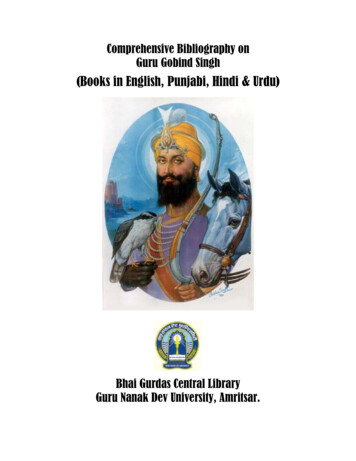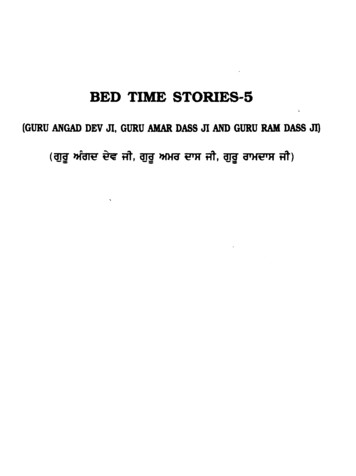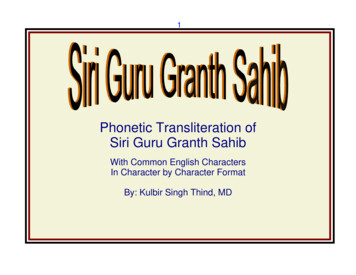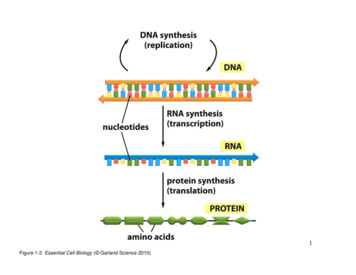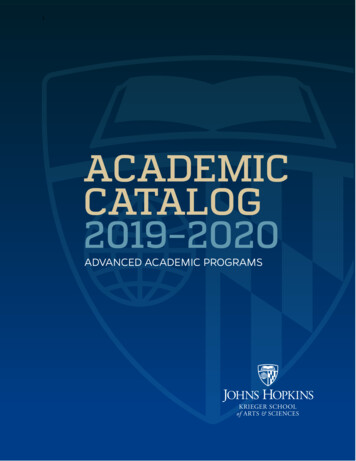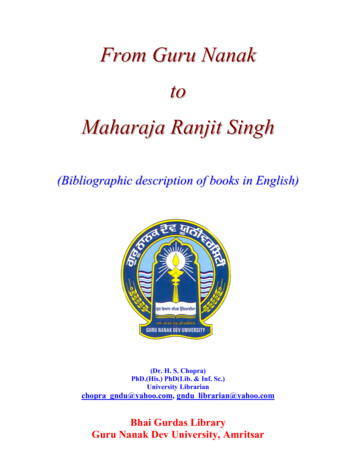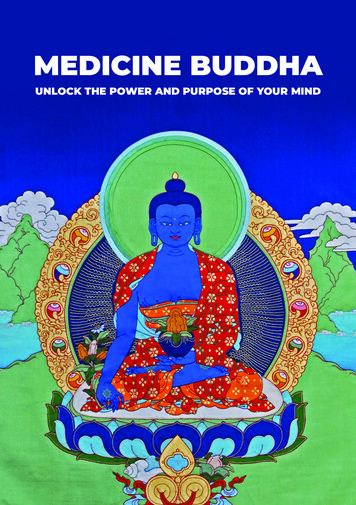
Transcription
The Garland of Guru’s Sayings
Sri Ramanasramam, Tiruvannamalai, IndiaFirst EditionSecond EditionThird EditionFourth Edition1000 copies::::199019962007 – 1000 copies2016CC No. : 1086ISBN : 978-81-8288-081-8Price: 100Published by:V.S. RamananPresidentSri RamanasramamTiruvannamalai 606 603Tamil Nadu, INDIAEmail : ashram@gururamana.orgWebsite : www.sriramanamaharshi.orgPrinted by:Prism Art PressChennai 600 014TAMIL NADU, INDIA
THE GARLAND OF GURU’S SAYINGSGURU VACHAKA KOVAITranslated by Prof. K. SWAMINATHANfrom original in Tamil by Sri MURUGANARSRI RAMANASRAMAMTIRUVANNAMALAIINDIA
PUBLISHER’S NOTEProfessor Swaminathan’s English rendering of GuruVachaka Kovai of Sri Muruganar has been serialised in TheMountain Path from 1964 onwards. The second edition of theTamil work published in 1971 added several new stanzas to thosein the first edition brought out in 1939 by Sri Ramana Padananda.Further, the elaborate commentary of Sri Sadhu Om, publishedby the Delhi Ramana Kendra in 1980, carries useful notes andexplanations in simple Tamil, which established the claim that thisTreatise provides the most precise, systematic and authoritativeexposition of Sri Bhagavan’s teaching, explaining step by stepthe theory, the practice and the experience of jnana, the Truthsupreme which is Being as Life Eternal, Pure Awareness,Perfect Bliss.Thus, the most comprehensive collection of the Maharshi’ssayings is Guru Vachaka Kovai (The Garland of Guru’sSayings) composed and strung together artistically by the poetSri Muruganar. In this massive Tamil work of 1282 stanzas (1254being Sri Muruganar’s handiwork and 28 the Maharshi’s), eachstanza presents, in a well wrought and finely polished setting,a pearl that fell from the Master’s lips. Not only are thesestanzas arranged in the most logically effective order, under231 chapters, but most of them were seen and approved by theMaster, who supplied some links and re-statements of his ownto emphasize a point or tighten up or clarify the argument. Thevalue of The Garland of Guru’s Sayings is not merely in itsliterary appeal to Tamil readers. The collection equals the Talksin comprehensiveness and authenticity. The Talks are informaland present the Maharshi’s teachings against the backgroundof the questions posed by enquirers. The Garland focuses thelight on what the Maharshi said regardless of when or why he
viThe Garland of Guru’s Sayingssaid it, and the sayings are strung together in a manner whichis intellectually satisfying.It has been well said by Sri Sadhu Om that Sri Muruganaris the main architect of The Ramana Prasthana Traya (Trinityof Scriptures). He elicited Upadesa Saram, he helped ingiving final form and a coherent structure to The Forty Verseson Reality, and he himself composed the bulk and finalizedthe arrangement of the stanzas in Guru Vachaka Kovai, asystematic and detailed exposition of the Master’s teachingwhich carries Sri Bhagavan’s imprimatur and which provides,for the Tamil reader at any rate, a perennial source of literaryenjoymentIn finalizing this translation and seeing it through thepress, the translator and the publishers acknowledge withgratitude the valuable assistance of a devotee, who, in thecourse of satsang with Sri Muruganar, acquired an immensereverence towards him.The Ashram has great pleasure in offering this Garlandas a centenary tribute to this great poet who lived and wroteas the bright shadow and the authentic voice of Sri Bhagavan.Sri Ramanasramam15.8.1990T.N. VENKATARAMANPresident, Board of Trustees
INTRODUCTIONBorn to Sri Krishna Iyer of Ramanathapuram in 1890, thechild was originally named Sambamurti. However, his officialname was C.K. Subramanya Iyer. He, who in later years wouldsing and pour out verses in torrents, could hardly speak and wasalmost dumb till the age of five. Having lost his father early inlife, he lived in Coimbatore and received his education there.He grew up in an atmosphere of Tamil learning andevinced a deep love for his mother tongue; consequently hespecialised in it and soon became a highly accomplished scholarin this ancient and vibrantly alive language. He was a Panditmember in the lexicon committee presided over by Dr. Chandler.Having studied the Tirukkural thoroughly he followedits pre cepts meticulously in his life. Out of love for Tamil hechanged his name to Mugavai Kanna Muruganar (see v. 13of The Garland), corresponding to his original name.Not only was he a noted scholar, but also a spiritually orientednationalist and he was greatly influenced by Gandhiji’s liberationmovement. His first volume of poems was “Swatantra Gitam”(‘Songs of Independence’). He first came to Sri Bhagavan in 1923.This darshan and the intense gaze of Sri Bhagavan transformedhis being. When thus he came under the spell of the Master, alllesser lights were absorbed in the radiance of His Presence andhe never again wrote on any theme other than the glory andthe sayings of the Master. Sri Muruganar himself tells us whathappened when he came to Sri Bhagavan:With blazing, bright, unwinking eyesHe gazed and drunk in my whole Being.Swept off by such enchanting beautyHis utter slave I have become.11Ramana Sannidhi Murai, v. 317, Decad of Servitude, translated byK. Swaminathan.
viiiThe Garland of Guru’s SayingsTo sing His praises, to praise His Presence and to explainHis teachings the poet uses words which, whether richly sensuousor austerely intellectual, are invariably appropriate, while hisrepertory of metrical form is astounding in its vastness, flexibilityand power. Like some great temple complex, with its shrinesand towers, its water tanks and groves, the immense output ofthis extraordinarily gifted poet constitutes a massive and worthymonument to the Master, whose mighty message Sri Muruganarmanages to convey, because he is himself a consummate andhumble scholar, poet, saint.Sri Muruganar’s self-effacement was total and he satimmortal in the shadow of Ramana’s Feet. He passed awayon August 28, 1973 amidst the chanting of the devotees inpraise of Sri Arunachala and Sri Ramana.Sri Ramanasramam29.9.1990K. Swaminathan
CONTENTSHeadingsVersesPART I1.2.3.4.5.6.Invocation to the Guru. 1Name and Genesis of this Treatise. 4This Treatise But Restores. 8Author’s Humble Apology. 10Dedication. 12The Author. 13THE .19.20.21.22.Invocation. 14Actuality of the World. 19Unreality of the World. 63Allurement of the World. 71Aridity of the World. 75Playing One’s Role in the World. 81Illusory Appearances (Vivarta). 83Doctrine of No Birth (Ajata). 100Why Diverse Theories of Creation. 102Part Played by God. 103The Three Prime Entities. 110Veiling (Tiroda). 116Individuality (Vyakti). 118Wrong Identification. 125The Pandit. 132The Poet. 138Futility of Mere Learning. 141Truth of Vedanta. 148The Course of Prarabdha. 150The Power of Prarabdha. 153False Jiva and Self. 154Strength of Vasanas. 155The Ego-Knot. 156
The Garland of Guru’s 51.52.53.54.55.56.57.VersesThe Ego’s Strength. 161The Ego’s Dance. 166Treachery to the Self. 177Heaven and Hell. 178Terror of Hell (Naraka). 180Victory over Naraka. 181Turning Inward. 184The Kingdom of God. 194Sivahood. 197Non-Difference of Hari and Hara. 200Sakti and Siva. 201Siva-Worship. 204Meaning of Prostration. 207Image-Worship. 208Sacred Ashes (Vibhuti). 209Riding the Bull. 214Sakti and Santi. 215Macro and Micro. 218Desire for Thaumaturgic Powers (Siddhis). 219True Immortality. 225Elixir for Immortality. 230Body-Preservation. 232Of Non-Attachment. 236Awareness IS Detachment. 243Mind’s Puissance. 244Inner Purity. 245Of Death. 247Locus of Life. 249The Heart. 253The True Guru. 266Guru’s Grace. 275Certitude. 288The Left-Over (Uchishtam). 301Reverence to the Guru. 304Guru’s Greatness. 321
xiVersesOf Satsang. 328The Greatness of Devotees. 333Of Brahma-Vidya (Knowledge of Brahman). 336The Living Truth in Religions. 338Infinite Vision. 343Ego-Loss. 351The True I. 359Self Awakening. 362Freedom from Sorrow. 367Desirelessness. 371Freedom from Bondage. 380Self-Enquiry. 384True Penance (Tapas). 408Awareness. 417Nirvana. 441Self-Realisation. 443Firm Awareness. 447Enjoyment of Bliss. 451Sleep. 455True Being. 463Ending of Doership. 466Non-Action. 476Self-Surrender. 477How to Treat Enemies. 488Moderation in Life. 491The Sin of Excess. 493Meekness. 494What is Worth Doing. 500PART II—CONTINUED PRACTICE1.2.3.4.5.Teaching and Learning. 502Mahavakyas. 505The Upanishads. 509Worship. 510Silent Worship. 520
The Garland of Guru’s .35.36.37.38.39.40.41.VersesVanity of Argument. 522Maya of Measurement. 527Indirect Knowledge. 529Jiva One Only. 534Knowledge and Ignorance. 536Illusion. 548Waking Dream. 553Different States. 566Deeds Good and Bad. 570Dyads and Triads. 575Sense Pleasures. 582Illusion of the Mind. 594Ignorance. 598Immaturity. 605Forgetfulness. 606Samsara. 613Afflictions. 617Wonderful Maya. 621The Harm of Praise. 623Evil of Egotism. 625Origin of Sorrow. 627The Jiva (Separate Self). 629The Jiva’s Unreality. 634The World’s “Reality”. 635Denotative Knowledge. 640Ending Indicative Knowledge. 645Love. 650Embodiment as Form. 656Five-Fold Function. 666Freedom from Doership. 668Jiva’s Creation and God’s. 669The Process of Neti (Not this). 671Freedom from Vasanas. 675True Fasting. 678Diet Regulation. 679True Purity. 680
70.71.72.73.74.75.76.77.xiiiVersesFreedom from Desire. 683Sense-Control. 685Conquest of the Senses. 688Asanas. 690Becoming Pure. 691Breath-Control. 700Secret of Karma. 703Japa. 706The True Temple. 711The Holy Name. 712Bhakti. 718Bhakti-Jnana Identity. 722Bhakti-Vichara. 724One-Pointed Devotion. 734Dhyana-Vichara. 738Meditation on Form. 742Meditation on Space. 743Meditation on Time. 746Steady, Continuous Meditation (Nididhyasana). 749Other Sadhanas. 755Aids to Enquiry. 758Completion of Sadhana. 765Meditation and Discrimination (Viveka). 769Pure Being (Summa Irutthal). 773The Separate “I”. 775The Basic Quest. 782Seeker’s Conduct. 786Peace. 796Disciple’s Conduct. 798Real Compassion for Creatures. 802Rites for Ancestors. 805Service to “Others”. 806Sympathy. 810Equality. 816Testimony of Conscience. 819Truthfulness. 820
The Garland of Guru’s hment. 822The Greatness of Renunciation. 828True Renunciation. 840The Whole Mind. 841Destruction of the Ego. 844True Being. 865Who is the Witness?. 869PART III—EXPERIENCE OF 8.19.20.21.22.23.24.25.26.27.Direct Knowledge. 878Eternal Awareness. 881Nirvikalpa Samadhi. 893Changelessness. 903Solitude. 908Non-Attachment. 909Destruction of Mind. 913The Defunct Mind. 924Omniscience. 926Transcendence of Turiya (Turiyatita). 937Wholeness and Movement. 941Severing the Knot. 942Fulfilment. 945Non-Existence of Suffering. 952The Pervasiveness of Deep Sleep. 957Waking Sleep. 959Non-Dual Awareness. 961Grace. 965Sat-Chit-Ananda. 971Being. 980All Is Brahman. 985Harmony. 989Childlikeness. 994Union with the Atman. 996The Grandeur of Awareness. 1000Cosmic Consciousness. 1005The Sky of Awareness. 1007
56.57.58.59.60.61.62.xvVersesThe Inner Space. 1016Making That Known. 1020The Atman. 1022The Puissance of the Self. 1030Nature of the Self. 1032The Grandeur of the Self (Atman). 1058The Self Supreme (Paramatman). 1069Freedom from Fear. 1078Advaita (Non-Duality). 1080Atheism. 1082True Faith. 1083Eternal Freedom. 1085Authentic Living. 1089The Formless. 1098Sahaja Nishta (Those in the Natural State). 1105The Sthitaprajna (Steadfast Awareness).1111After the Knot is Cut Asunder. 1113The Power of the Great Ones. 1125Service to the Great Ones. 1130Ending of Vasanas. 1131Jivanmuktas (Liberated while Alive). 1135Jnanis. 1152The Jnani’s Actions. 1160Self-Abidance. 1167Might of Mouna. 1172Pure Mouna. 1183Supreme Bhakti. 1205The Miracle of Jnana. 1212Brahman. 1215Mukti. 1221The Truth Supreme. 1227True Being. 1230Transcendence of Thought. 1237Describing the Experience. 1240Equanimity. 1249Invocation. 1254
xviThe Garland of Guru’s SayingsPageAppendix.241Glossary.243Index.249Sri Bhagavan’s verses (BH) with their correspondingreference to The Collected Works. (The no. of the versegiven with each verse is that of the preceding verse).BH 1(125) The Supplement to The Forty Verses on Reality v.12BH 2(169)—— v.15BH 3(171)—— v.17BH 4(182) Dipavali (Occasional v.7)BH 5(183) Dipavali (Occasional v.8)BH 6(216) Stray Verse 5BH 7(222) The Supplement to The Forty Verses on Reality v.16BH 8(262) Five Verses to the Self v.3BH 9(565)— v.1BH 10(682) Stray Verse 3BH 11(702) The Supplement to The Forty Verses on Reality v.14BH 12(706) Stray Verse 2BH 13(731) Stray Verse 4BH 14(801) The Supplement to The Forty Verses v.39BH 15(802) Stray Verse 7BH 16(815) Apology to HornetsBH 17(848) The Supplement to The Forty Verses on Reality v.13BH 18(939)——BH 19(958) Sleep While Awake v.32BH 20(1031) The Supplement to The Forty Verses on Reality v.28BH 21(1105)—— v.31BH 22(1134)—— v.30BH 23(1145)—— v.33BH 24(1148) Occasional Verse 9 (from the Rama Gita)BH 25(1151) The Forty Verses on Reality v.31BH 26(1166) Stray Verse 6 (from the Bhagavad Gita)BH 27(1181) Stray Verse 8 (from the Panchadasi)BH 28(1227) Stray Verse 9 (from Gaudapada Karika on theMandukya Upanishad).
THE GARLAND OF GURU’S SAYINGS1. Invocation to the Guru1To save from dire despondencyThose who yearn for, and yet are, far,Far from the goal of final Freedom,This Lamp of Guru’s wisdom litTo put to flight the illusion of ‘I’And ‘mine’, shines as the very Self.2While I lay writhing in the bodyMistaking it for me, the gracious,Silent guru took pity on meAnd made me see that I was notThis form inert, decaying, butImperishable true Awareness.With His twin Feet I crown my head.3The Sage accomplished who revealsWith clarity and certitudeThe ultimate Truth which reconcilesAll the discordant creeds and doctrines,His Feet my head wears as a crown.2. Name and Genesis of this Treatise4Not my poor mind unlit by anyVision of Truth, but Master Ramana’sBright, eternal wisdom, isThe flame that shines clear in this LampOf Being Supreme.5The gracious Master, the embodimentOf the one bright, true Being-AwarenessUttered many sayings for dispellingIgnorance. Some of these I treasuredIn my memory and repeatHere in this treatise.
2The Garland of Guru’s Sayings6In the non-dual state, whereinAbiding Ramana made me his,Where he and I together sharedA common being, I learnt the TruthSupreme, transcendent, which I hopeHere to expound a little.7My God, my Guru, Ramana clearedMy mind of the dense ego-cloudAnd graciously revealed to meThe Truth transcendent. ’Tis this visionSplendid that with loving careI weave into this Garland fair.3. This Treatise but Restores8The Self supreme stands ever as allThings everywhere, one does not reach it.This Lamp of Being supreme onlyReveals what IS, free from all wavesOf Dharma and kama.9The Self, pure Being that shines as Bliss,Is the sole home of all the worldsHere and hereafter. Prompt and properRestoration to the SelfIs what this treatise offers, notWays dubious to some distant goal.4. Author’s Humble Apology10“Garland of Guru’s Sayings”, this rhymingTreatise was not thought out or sungBy me, this half-wit. Venkata,The pure one, thought-free sang, it seems,And so it came to be.
The Garland of Guru's Sayings11For what I have not with my mindComposed, why humbly apologise?Responsibility for thisWhole treatise rests with Him, the MasterKnown in the pure heart’s blissful silence.5. Dedication12She gave me birth and gave me thusFreedom from ignorance, bliss eternal,To this most innocent mother of mine,To her dear memory is this treatiseDuly dedicated.6. The Author13Some sayings of the guru, KannaMuruga stored and strung togetherAs a garland bright of Being supreme.His Eye of grace, at his Master’s Feet,Had found the meaning, beauty and blissOf all this universe.[This stanza is a tribute from an admirer of the poet, whoseoriginal name was Krishnaswami Subramanyan. Krishna Kanna. Subramanyan Murugan. Muruganar is the honorificplural of Murugan.]3
PART ITHE QUESTInvocation14The ocean-girdle
sayings is Guru Vachaka Kovai (The Garland of Guru's Sayings) composed and strung together artistically by the poet Sri Muruganar. In this massive Tamil work of 1282 stanzas (1254 being Sri Muruganar's handiwork and 28 the Maharshi's), each stanza presents, in a well wrought and finely polished setting,


